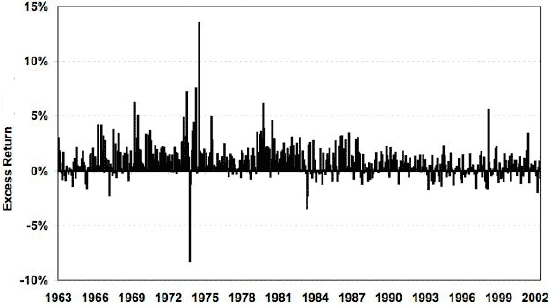We occasionally select for retrospective review an all-time “best selling” research paper of the past few years from the General Financial Markets category of the Social Science Research Network (SSRN). Here we summarize the February 2006 version of the paper entitled “Pairs Trading: Performance of a Relative Value Arbitrage Rule” (download count over 14,500) by Evan Gatev, William Goetzmann and Geert Rouwenhorst. The study tests the trading of mismatches in the dividend-adjusted prices of pairs of stocks that historically move together. Specifically, when the price spread between such a pair widens, short the winner and buy the loser and hold until prices converge. Using daily stock prices for a broad sample of reasonably liquid stocks over the period 1962-2002, the authors conclude that:
- Trading rules are:
- Select pairs of stocks based on closely tracking prices over past year and trade them over the following six months.
- Initiate positions for a pair when prices diverge by more than two historical standard deviations, and exit when the prices next cross (or at the end of the six-month trading interval).
- These rules generate an average of two trades per pair during the six-month trading interval, with an average duration of 3-4 months for each trade.
- Paired stocks are usually, but not always, of the same industry. They usually differ in market capitalization.
- Self-financing portfolios of best-matching pairs yield an average annualized excess return of up to 11% over the entire sample period (before trading frictions), about twice the excess return of the S&P 500 index with less than half standard deviation. Portfolios of the 20 best-matching pairs generate negative returns in only 71 of 474 months.
- Pairs trading returns are uncorrelated with S&P 500 index returns.
- With reasonable estimates of trading frictions, pairs trading is profitable over the historical sample period (1962-1998) and over a four-year out-of-sample test (1999-2002). While raw profitability of pairs trading decreases for a post-1988 subsample, public dissemination of original study results in 1998 has apparently not depressed risk-adjusted returns.
- Robustness of excess returns indicates that pairs trading exploits temporary mispricing of close substitutes.
The following chart, taken from the paper, shows the monthly excess raw returns from self-financing portfolios of the 20 best-matching pairs over the entire sample period. Pairs trading generated strong raw returns in the 1970s and 1980s, followed by more modest performance.

In summary, hedge portfolios of matched pairs of stocks has offered persistently solid risk-adjusted returns, but diminishing raw returns, over the past 40 years.